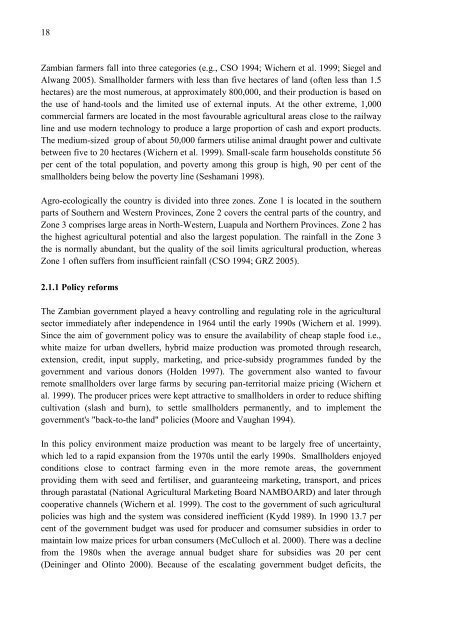Rural Income Generation and Diversification - A Case Study ... - Doria
Rural Income Generation and Diversification - A Case Study ... - Doria
Rural Income Generation and Diversification - A Case Study ... - Doria
Create successful ePaper yourself
Turn your PDF publications into a flip-book with our unique Google optimized e-Paper software.
18<br />
Zambian farmers fall into three categories (e.g., CSO 1994; Wichern et al. 1999; Siegel <strong>and</strong><br />
Alwang 2005). Smallholder farmers with less than five hectares of l<strong>and</strong> (often less than 1.5<br />
hectares) are the most numerous, at approximately 800,000, <strong>and</strong> their production is based on<br />
the use of h<strong>and</strong>-tools <strong>and</strong> the limited use of external inputs. At the other extreme, 1,000<br />
commercial farmers are located in the most favourable agricultural areas close to the railway<br />
line <strong>and</strong> use modern technology to produce a large proportion of cash <strong>and</strong> export products.<br />
The medium-sized group of about 50,000 farmers utilise animal draught power <strong>and</strong> cultivate<br />
between five to 20 hectares (Wichern et al. 1999). Small-scale farm households constitute 56<br />
per cent of the total population, <strong>and</strong> poverty among this group is high, 90 per cent of the<br />
smallholders being below the poverty line (Seshamani 1998).<br />
Agro-ecologically the country is divided into three zones. Zone 1 is located in the southern<br />
parts of Southern <strong>and</strong> Western Provinces, Zone 2 covers the central parts of the country, <strong>and</strong><br />
Zone 3 comprises large areas in North-Western, Luapula <strong>and</strong> Northern Provinces. Zone 2 has<br />
the highest agricultural potential <strong>and</strong> also the largest population. The rainfall in the Zone 3<br />
the is normally abundant, but the quality of the soil limits agricultural production, whereas<br />
Zone 1 often suffers from insufficient rainfall (CSO 1994; GRZ 2005).<br />
2.1.1 Policy reforms<br />
The Zambian government played a heavy controlling <strong>and</strong> regulating role in the agricultural<br />
sector immediately after independence in 1964 until the early 1990s (Wichern et al. 1999).<br />
Since the aim of government policy was to ensure the availability of cheap staple food i.e.,<br />
white maize for urban dwellers, hybrid maize production was promoted through research,<br />
extension, credit, input supply, marketing, <strong>and</strong> price-subsidy programmes funded by the<br />
government <strong>and</strong> various donors (Holden 1997). The government also wanted to favour<br />
remote smallholders over large farms by securing pan-territorial maize pricing (Wichern et<br />
al. 1999). The producer prices were kept attractive to smallholders in order to reduce shifting<br />
cultivation (slash <strong>and</strong> burn), to settle smallholders permanently, <strong>and</strong> to implement the<br />
government's "back-to-the l<strong>and</strong>" policies (Moore <strong>and</strong> Vaughan 1994).<br />
In this policy environment maize production was meant to be largely free of uncertainty,<br />
which led to a rapid expansion from the 1970s until the early 1990s. Smallholders enjoyed<br />
conditions close to contract farming even in the more remote areas, the government<br />
providing them with seed <strong>and</strong> fertiliser, <strong>and</strong> guaranteeing marketing, transport, <strong>and</strong> prices<br />
through parastatal (National Agricultural Marketing Board NAMBOARD) <strong>and</strong> later through<br />
cooperative channels (Wichern et al. 1999). The cost to the government of such agricultural<br />
policies was high <strong>and</strong> the system was considered inefficient (Kydd 1989). In 1990 13.7 per<br />
cent of the government budget was used for producer <strong>and</strong> comsumer subsidies in order to<br />
maintain low maize prices for urban consumers (McCulloch et al. 2000). There was a decline<br />
from the 1980s when the average annual budget share for subsidies was 20 per cent<br />
(Deininger <strong>and</strong> Olinto 2000). Because of the escalating government budget deficits, the

















